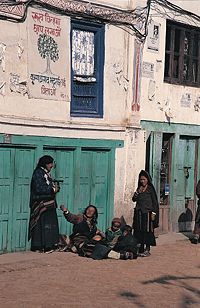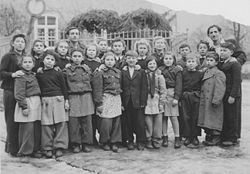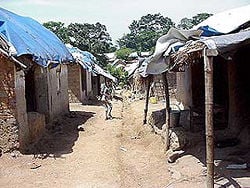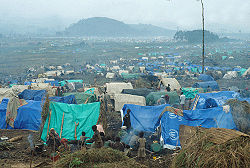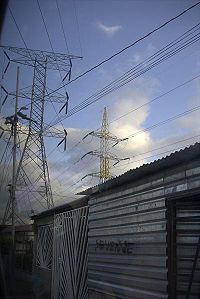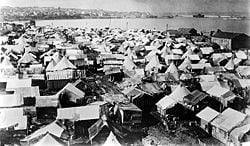Difference between revisions of "Refugee" - New World Encyclopedia
(Submitted) |
|||
| Line 1: | Line 1: | ||
| − | {{Claimed}}{{Started}}{{Contracted}} | + | {{Claimed}}{{Started}}{{Contracted}}{{Submitted}}{{Images OK}} |
[[Category:Politics and social sciences]] | [[Category:Politics and social sciences]] | ||
[[Category:Sociology]] | [[Category:Sociology]] | ||
Revision as of 15:32, 25 August 2007
Refugee was defined as a legal group in response to the large numbers of people fleeing Eastern Europe following World War II. The lead international agency coordinating refugee protection is the Office of the United Nations High Commissioner for Refugees (UNHCR), which counted over eight million refugees worldwide at the beginning of 2006. This was the lowest number since 1980. [1] The major exception are the four million Palestinian refugees under the authority of the United Nations Relief and Works Agency for Palestine Refugees in the Near East (UNRWA), who are the only group to be granted refugee status to the descendants of refugees according to the above definition. [2] The U.S. Committee for Refugees and Immigrants gives the world total as over twelve million refugees and estimates there are over thirty million displaced by war, including internally displaced persons, who remain within the same national borders. The majority of refugees who leave their country seek asylum in countries neighboring their country of nationality. The "durable solutions" to refugee populations, as defined by UNHCR and governments, are: voluntary repatriation to the country of origin; local integration into the country of asylum; and resettlement to a third country. [3]
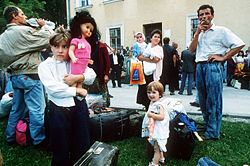
As of 2006, the largest source countries of refugees are the Palestinian Territories, Afghanistan, Iraq, Myanmar, and Sudan. The country with the largest number of IDPs is Sudan, with over five million. According to United Nations estimates, there may be as many as four million Iraqis made homeless inside and outside the Iraq by the violence and forty thousand Iraqis every month are losing their homes and becoming refugees. This has become the largest refugee crisis in Middle East since the upheaval that greeted the creation of Israel nearly sixty years ago. In the past five years barely one hundred people from Iraq have been granted refuge in the United States.
Definition
According to the United Nations Convention Relating to the Status of Refugees, a refugee is a person who is owing to a well-founded fear of being persecuted for reasons of race, religion, nationality, membership of a particular social group, or political opinion, is outside the country of their nationality, and is unable to or, owing to such fear, is unwilling to avail him/herself of the protection of that country. [4] The concept of a refugee was expanded by the Conventions’ 1967 Protocol and by regional conventions in Africa and Latin America to include persons who had fled war or other violence in their home country. A person who is seeking to be recognized as a refugee is an asylum seeker.
Under international law, refugees are individuals who are outside their country of nationality or habitual residence; have a well-founded fear of persecution because of their race, religion, nationality, membership in a particular social group or political opinion; and are unable or unwilling to avail themselves of the protection of that country, or to return there, for fear of persecution. [5]
Refugees are a subgroup of the broader category of displaced persons. Environmental refugees (people displaced because of environmental problems such as drought) are not included in the definition of "refugee" under international law, as well as internally displaced people. According to international refugee law, a refugee is someone who seeks refuge in a foreign country because of war and violence, or out of fear of persecution "on account of race, religion, nationality, political opinion, or membership in a particular social group" (to use the terminology from U.S. law).
The practical determination of whether a person is a refugee or not is most often left to certain government agencies within the host country. This can lead to abuse in a country with a very restrictive official immigration policy; for example, that the country will neither recognize the refugee status of the asylum seekers nor see them as legitimate migrants and treat them as illegal aliens.
On the other hand, fraudulent requests in an environment of lax enforcement could lead to improper classification as refugee, resulting in the diversion of resources from those with a genuine need. The percentage of asylum/refugee seekers who do not meet the international standards of special-needs refugee, and for whom resettlement is deemed proper, varies from country to country. Failed asylum applicants are most often deported, sometimes after imprisonment or detention, as in the United Kingdom.
A claim for asylum may also be made onshore, usually after making an unauthorized arrival. Some governments are relatively tolerant and accepting of onshore asylum claims; other governments will not only refuse such claims, but may actually arrest or detain those who attempt to seek asylum. A small number of governments, such as that of Australia, have a policy of mandatory detention of asylum seekers.
History
Early History
The concept of sanctuary, in the meaning that a person who fled into a holy place could not be harmed without inviting divine retribution, was understood by the ancient Greeks and ancient Egyptians. However, the right to seek asylum in a church or other holy place, was first codified in law by King Ethelbert of Kent in about 600 C.E. Similar laws were implemented throughout Europe in the Middle Ages. The related concept of political exile also has a long history: Ovid was sent to Tomis and Voltaire was exiled to England. Through the 1648 Peace of Thirty Years' War recognized each others' sovereignty. However, it was not until the advent of romantic nationalism in late eighteenth century Europe that nationalism became prevalent enough that the phrase "country of nationality" became meaningful and people crossing borders were required to provide identification.
The term "refugee" is sometimes applied to people who may have fit the definition, if the 1951 Convention was applied retroactively. There are many candidates. For example, after the Edict of Fontainebleau in 1685 outlawed Protestantism in France, hundreds of thousands of Huguenots fled to England, the Netherlands, Switzerland, Norway, Denmark and Prussia. Various groups of people were officially designated refugees beginning in World War I.
The first international coordination on refugee affairs was by the League of Nations' High Commission for Refugees. The Commission, led by Fridtjof Nansen, was set up in 1921 to assist the approximately one and a half million persons who fled the Russian Revolution of 1917 and the subsequent civil war (1917–1921), most of them aristocrats fleeing the Communist government. In 1923, the mandate of the Commission was expanded to include the more than one million Armenians who left Turkish Asia Minor in 1915 and 1923 due to a series of events now known as the Armenian Genocide. Over the next several years, the mandate was expanded to include Assyrians and Turkish refugees. [6] In all of these cases, a refugee was defined as a person in a group for which the League of Nations had approved a mandate, as opposed to a person to whom a general definition applied.
In 1930, the Nansen International Office for Refugees was established as a successor agency to the Commission. Its most notable achievement was the Nansen passport, a passport for refugees, for which it was awarded the 1938 Nobel Peace Prize. The Nansen Office was plagued by inadequate funding, rising numbers of refugees and the refusal by League members to let the Office assist their own citizens. Regardless, it managed to convince fourteen nations to sign the Refugee Convention of 1933, a weak human right instrument, and assist over one million refugees. The rise of Nazism led to such a severe rise in refugees from Germany that in 1933 the League created a High Commission for Refugees Coming from Germany. The mandate of this High Commission was subsequently expanded to include persons from Austria and Sudetenland. On 31 December 1938, both the Nansen Office and High Commission were dissolved and replaced by the Office of the High Commissioner for Refugees under the Protection of the League.[6] This coincided with the flight of several hundred thousand Spanish Republicans to France after their loss to the Nationalists in 1939 in the Spanish Civil War.
Evolving Refugee Organizations
The conflict and political instability during World War II led to massive amounts of forced migration. In 1943, the Allies created the United Nations Relief and Rehabilitation Administration (UNRRA) to provide aid to areas liberated from Axis powers, including parts of Europe and China. This included returning over seven million refugees, then commonly referred to as displaced persons or DPs, to their country of origin and setting up displaced persons camps for one million refugees who refused to be repatriated. Also, thousands of former Russian citizens were repatriated by force (against their will) into the USSR. [7] At the time, UNRRA was shut down in 1949 and its refugee tasks given to the International Refugee Organization (IRO).
After the defeat of Germany in World War II, the Potsdam Conference authorized the expulsion of German minorities from a number of European countries (including Soviet- and Polish-annexed pre-war east Germany), meaning that 12,000,000 ethnic Germans were displaced to the reallocated and divided territory of Allied-occupied Germany. Between the end of World War II and the erection of the Berlin Wall in 1961, more than three million refugees from East Germany traveled to West Germany for asylum from the Soviet occupation.
The International Refugee Organization was a temporary organization of the United Nations (UN), which itself had been founded in 1945, with a mandate to largely finish the UNRRA's work of repatriating or resettling European refugees. It was dissolved in 1952 after resettling about one million refugees. The definition of a refugee at this time was an individual with either a Nansen passport or a "Certificate of Eligibility" issued by the International Refugee Organization.
Rise of the UNHCR
Headquartered in Geneva, Switzerland, the Office of the United Nations High Commissioner for Refugees (UNHCR) (established December 14, 1950) protects and supports refugees at the request of a government or the United Nations and assists in their return or resettlement. It succeeded the earlier International Refugee Organization and the even earlier United Nations Relief and Rehabilitation Administration (which itself succeeded the League of Nations' Commissions for Refugees).
UNHCR provides protection and assistance not only to refugees, but also to other categories of displaced or needy people. These include asylum seekers, refugees who have returned home but still need help in rebuilding their lives, local civilian communities directly affected by the movements of refugees, stateless people and so-called internally displaced people (IDPs).IDPs are civilians who have been forced to flee their homes, but who have not reached a neighboring country and therefore, unlike refugees, are not protected by international law and may find it hard to receive any form of assistance.
UNHCR was awarded the Nobel Peace Prize in 1954 and 1981. The agency is mandated to lead and co-ordinate international action to protect refugees and resolve refugee problems worldwide. Its primary purpose is to safeguard the rights and well-being of refugees. It strives to ensure that everyone can exercise the right to seek asylum and find safe refuge in another State, with the option to return home voluntarily, integrate locally or to resettle in a third country.
UNHCR's mandate has gradually been expanded to include protecting and providing humanitarian assistance to what it describes as other persons "of concern," including internally-displaced persons (IDPs) who would fit the legal definition of a refugee under the 1951 Refugee Convention and 1967 Protocol, the 1969 Organization for African Unity Convention, or some other treaty if they left their country, but who presently remain in their country of origin. UNHCR thus has missions in Colombia, Democratic Republic of the Congo, Serbia and Montenegro and Côte d'Ivoire to assist and provide services to IDPs.
As of 2007 there are nearly twenty-five million internally displaced people and close to ten million refugees worldwide. [8]
Refugee camps
A refugee camp is a place built by governments or NGOs (such as the ICRC) to receive refugees. People may stay in these camps, receiving emergency food and medical aid, until it is safe to return to their homes. In some cases, often after several years, other countries decide it will never be safe to return these people, and they are resettled in "third countries," away from the border they crossed.
However, more often than not, refugees are not resettled. Rather, they are "warehoused"-they are denied their basic human rights including the right of movement, employment, and ownership of property.
For 10, 20 or 40 years, men, women, and children have been confined to their camps-often arrested and deported to their native countries if they stray too far.
Camps are the breeding ground for disease, child soldiering, terrorist recruitment, and physical and sexual violence. And these camps are often funded by UNHCR and United States.
Globally, about 17 countries (Australia, Benin, Brazil, Burkina Faso, Canada, Chile, Denmark, Finland, Iceland, the Republic of Ireland, Mexico, the Netherlands, New Zealand, Norway, Sweden, the United Kingdom, and the United States) regularly accept quota refugees from places such as refugee camps. Usually these are people who have escaped war. In recent years, most quota refugees have come from Iran, Afghanistan, Iraq, Liberia, Somalia, and Sudan, which have been in various wars and revolutions, and the former Yugoslavia, due to the Yugoslav wars.
According to Agence France-Presse, Japan accepted just 10 people into the country as refugees in 2003, the lowest number since it let in one in 1997, the justice ministry said friday. Despite denying them refugee status, Japan accepted 16 more people on special humanitarian grounds during the year — also the lowest figure since 1997, when it accepted three, the ministry said. In contrast, 336 people applied for refugee status in Japan over the year, the highest figure in two years. Various international organisations, including the UN High Commissioner for Refugees, have asked Japan to accept more refugees.
Japan accepted just 16 refugees in 1999, while the United States took in 85,010 for resettlement, according to the UNHCR. New Zealand, which is smaller than Japan, accepted 1,140 refugees in 1999. Amnesty International Japan said in January that the country is violating international refugee and anti-torture conventions, citing the case of an Iranian applicant who was arrested days after being deported in October. Japanese court rejected the asylum request from a gay Iranian who faced the death penalty if his sexual orientation was discovered in his homeland.
Middle-East
Palestinian Refugees
Following the 1948 proclamation of the State of Israel, the first Arab-Israeli War began. Many Palestinians had already become refugees, and the Palestinian Exodus (Nakba) continued through the 1948 Arab-Israeli War and after the armistice that ended it. The great majority have remained refugees for generations as they were not permitted to return to their homes or to settle in the Arab countries where they lived. The refugee situation and the presence of numerous refugee camps continues to be a point of contention in the Arab-Israeli conflict.
The final estimate of refugee numbers was over seven hundred thousand according to the United Nations Concilation Commission. Palestinian refugees from 1948 and their descendants do not come under the 1951 UN Convention Relating to the Status of Refugees, but under the UN Relief and Works Agency for Palestine Refugees in the Near East, which created its own criteria for refugee classification. As such they are the only refugee population legally defined to include descendants of refugees, as well as others who might otherwise be considered internally displaced persons.
As of December 2005, the World Refugee Survey of the U.S. Committee for Refugees and Immigrants estimates the total number of Palestinian refugees to be close to three million.
Jewish Refugees
In Europe, the Nazi persecution culminated in the Holocaust of European Jews. The Bermuda Conference, Evian Conference and other attempts failed to resolve the problem of Jewish refugees from Europe. Between the two wars, Jewish immigration to Palestine was encouraged by the nascent zionist mouvement but severely restricted by the British mandate government in Palestine. Soon following independence of Israel in 1948, the state adopted the law of return granting Israeli citizenship to any Jew immigrant. With the gates of Palestine now opened, some seven hundred thousand refugees flooded this small, young and dry country at a time of war. This human flood was housed in tent cities called Ma'abarot. More recently, following the dissolution of the USSR, a second surge of seven hundred thousand Russian Jews fled to Israel between 1990 and 1995.
In the East, Jews have lived in what are now Arab states at least since the Babylonian captivity (597 B.C.E.). In 1945, there were about eight hundred thousand Jews living in communities throughout the Arab world. After the creation of the state of Israel and the 1948 Arab-Israeli War that ensued, conditions for Jews in the Arab world deteriorated. The situation worsened following the 1967 Six-Day War. Over the next few decades, most would leave the Arab world, nearly six hundred thousand, most finding refuge in Israel. Today, in all the Arab countries except Morocco, the Jewish population has disappeared or shrunk below survival levels.
Iraq Wars Refugees
The current Iraq war has generated millions of refugees and internally displaced persons. According to the UNHCR, as of April 2007, nearly two million Iraqis have been forced to flee their country, most to Syria and Jordan, and close to two million others are displaced internally.
The Iran-Iraq war from 1980 to 1988, the 1990 Iraqi invasion of Kuwait, the first Gulf War and subsequent conflicts all generated hundreds of thousands if not millions of refugees. Iran also provided asylum for over one million Iraqi refugees who had been uprooted as a result of the Persian Gulf War (1990–91).
Asia
Afghanistani Refugees
From the Soviet invasion of Afghanistan in 1979 through the early 1990s, the Afghan War (1978–92) caused more than six million refugees to flee to the neighboring countries of Pakistan and Iran, making Afghanistan the greatest refugee-producing country. The number of refugees fluctuated with the waves of the war, with thousands more fleeing after the Taliban takeover of 1996. The U.S. invasion of Afghanistan in 2001 and continued ethnic cleansing and reprisals also caused additional displacement. Though there has been some repatriation sponsored by the U.N. from Iran and Pakistan, a 2007 UNHCR census identified over two million Afghan refugees still living in Pakistan alone.
Indian Refugees
The partition of the Indian subcontinent into India and Pakistan in 1947 resulted in the largest human movement in history: an exchange of eighteen million Hindus and Sikhs (from Pakistan) for Muslims (from India). During the Bangladesh Liberation War in 1971, owing to the West Pakistani Army's Operation Searchlight, more than ten million Bengalis fled to neighboring India.
As a result of the Bangladesh Liberation War, on March of 1971, Prime Minister of India, Indira Gandhi, expressed full support of her Government to the Bangladeshi struggle for freedom. The Bangladesh-India border was opened to allow the tortured and panic-stricken Bengalis safe shelter in India. The governments of West Bengal, Bihar, Assam, Meghalaya and Tripura established refugee camps along the border. Exiled Bangladeshi army officers and voluntary workers from India immediately started using these camps for recruitment and training of freedom fighters (members of Mukti Bahini).
As the massacres in East Pakistan escalated, an estimated ten million refugees fled to India, causing financial hardship and instability therein. There are between one hundred and twenty six thousand and one hundred and fifty nine thousand Biharis who have been living in camp-like situations in Bangladesh ever since the war, whom Pakistan has been unwilling to accept.
Southeast Asia
Following the communist takeovers in Vietnam, Cambodia, and Laos in 1975, about three million people attempted to escape in the subsequent decades. With massive influx of refugees daily, the resources of the receiving countries were severely strained. Large numbers of Vietnamese refugees came into existence after 1975 when South Vietnam fell to the communist forces. Many tried to escape, some by boat, thus giving rise to the phrase "boat people." The Vietnamese refugees emigrated to Hong Kong, Israel, France, the United States, Canada, Australia, and other countries, creating sizable expatriate communities, notably in the United States. The plight of the boat people became an international humanitarian crisis. The United Nations High Commissioner for Refugees (UNHCR) set up refugee camps in neighboring countries to process the boat people.
The Mien or Yao lived in northern Vietnam, northern Laos and northern Thailand. In 1975, the Pathet Lao forces began seeking reprisal for the involvement of many Mien as soldiers in the CIA-sponsored Secret War in Laos. As a token of appreciation to the Mien and Hmong people who served in the CIA secret army, the United States accepted many of the refugees as naturalized citizens (Mien American). Many more Hmong continue to seek asylum in neighboring Thailand.
Africa
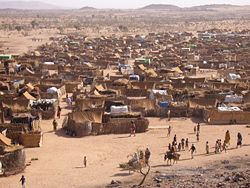
Since the 1950s, many nations in Africa have suffered civil wars and ethnic strife, thus generating a massive number of refugees of many different nationalities and ethnic groups. The division of Africa into European colonies in 1885, along which lines the newly independent nations of the 1950s and 1960s drew their borders, has been cited as a major reason why Africa has been so plagued with intrastate warfare. The number of refugees in Africa increased from nearly nine hundred thousand in 1968 to close to seven million by 1992. By the end of 2004, that number had dropped to under three million refugees.
Many refugees in Africa cross into neighboring countries to find haven; often, African countries are simultaneously countries of origin for refugees and countries of asylum for other refugees. The Democratic Republic of Congo, for instance, was the country of origin for nearly five hundred thousand refugees at the end of 2004, but a country of asylum for close to two hundred thousand other refugees.
Great Lakes Refugee Crisis
In the aftermath of the 1994 Rwandan Genocide, over two million people fled into neighboring countries, in particular Zaire. The refugee camps soon came to be controlled by the former government and Hutu militants who used the camps as bases to launch attacks against the new government in Rwanda. Little action was taken to resolve the situation and the crisis did not end until Rwanda-supported rebels forced the refugees back across the border in the beginning of the First Congo War.
Europe
Beginning in 1991, political upheavals in the Balkans such as the breakup of Yugoslavia, displaced about nearly three million people by mid-1992. Seven hundred thousand of them sought asylum in Europe. In 1999 around one million Albanians escaped from Serbian persecutions.
From 1992 the ongoing conflict has taken place in Chechenya, Caucasus due to independence proclaimed by this republic in 1991 which is not accepted by the Russian Federation. This resulted in the displacement of almost two million people.
The Americas
More than one million Salvadorans were displaced during the Salvadoran Civil War from 1975 to 1982. About half went to the United States, most settling in the Los Angeles area. There was also a large exodus of Guatemalans during the 1980s, trying to escape from the Civil War and genocide there as well. These people went to southern Mexico and the U.S.
From 1991 through 1994, following the military coup d'état against President Jean-Bertrand Aristide, thousands of Haitians fled violence and repression by boat. Although most were repatriated to Haiti by the U.S. government, others entered the United States as refugees. Haitians were primarily regarded as economic migrants from the grinding poverty of Haiti, the poorest nation in the Western Hemisphere.
The victory of the forces led by Fidel Castro in the Cuban Revolution led to a large exodus of Cubans between 1959 and 1980. Dozens of Cubans yearly continue to risk the waters of the Straits of Florida seeking better economic and political conditions in the U.S. In 1999 the highly publicized case of six year old Elián González brought the covert migration to international attention. Measures by both governments have attempted to address the issue, the U.S. instituted a Wet feet, dry feet policy allowing refuge to those travelers who manage to complete their journey, and the Cuban government have periodically allowed for mass migration by organizing leaving posts. The most famous of these agreed migrations was the Mariel boatlift of 1980.
It is now estimated by the U.S. Committee on Refugees and Immigrants that there are around one hundred and fifty thousand Colombians in "refugee-like situations" in the United States, not recognized as refugees or subject to any formal protection.
Issues Facing Refugees
An estimated eighty percent of refugees are women and children. They often carry the heaviest burden of survival for themselves and their families. Women and adolescent girls in refugee settings are especially vulnerable to exploitation, rape, abuse and other forms of gender-based violence. Children and youth constitute approximately fifty percent of all refugees worldwide. They are the deliberate targets of abuse, and easy prey to military recruitment and abduction. They typically miss out on years of education. More than forty million children living in conflict-affected areas don’t have a chance to go to school.
Girls in particular face significant obstacles accessing education. Families who lack funds for school fees, uniforms, books, etc. are often influenced by cultural norms to prioritize education for boys over girls. Girls are typically pulled out of school before boys, often to help with traditional care-giving/work roles including care for younger siblings, gathering firewood and cooking. Early or forced marriage can also derail a girl’s education.
Without an education, refugee women and youth often struggle to support themselves and their families. With refugees displaced for longer periods of time than ever before (nearly seventy percent of all refugees are now displaced for an average of seventeen years), the ability for refugees—particularly women and youth— to earn a living and sustain themselves and their families (“livelihoods”) is becoming even more critical. Livelihoods are vital for the social, emotional and economic well being of displaced persons and are a key way to increase the safety of displaced women and adolescents. Lack of education, minimal job prospects, and disproportionate responsibility at home all limit the livelihood opportunities of women and youth.
On occasion, people who have been uprooted from their homes come to the United States in search of safe haven. They may be detained by the U.S. government, often until their asylum cases are decided—which can amount to days, weeks, months or even years. Many of those detained are women and children who seek asylum in the United States after fleeing from gender- and age-related persecution. Sometimes the children are alone, having fled abusive families or other human rights abuses. Detained women asylum seekers are also particularly vulnerable to abuse in detention. Women and children asylum seekers who reach the United States are often imprisoned and at times subjected to inhumane conditions, abuse and poor medical care, and denied legal representation and other services. Refugee advocacy organizations, including the Women’s Commission for Refugee Women and Children, focus their programs and advocacy specifically on the needs of refugee women, children and youth.
Apart from physical wounds or starvation, a large percentage of refugees develops symptoms of post-traumatic stress disorder (PTSD) or depression. These long-term mental problems can severely impede the functionality of the person in everyday situations; it makes matters even worse for displaced persons who are confronted with a new environment and challenging situations. They are also at high risk for suicide [9].
Among other symptoms, post-traumatic stress disorder involves anxiety, over-alertness, sleeplessness, chronic fatigue syndrome, motor difficulties, failing short term memory, amnesia, nightmares and sleep-paralysis. Flashbacks are characteristic to the disorder: The patient experiences the traumatic event, or pieces of it, again and again. Depression is also characteristic for PTSD-patients and may also occur without accompanying PTSD.
PTSD was diagnosed in nearly one third of the Palestinian children, most of whom were refugees, males, and working. The participants were one thousand children aged twelve to sixteen years from governmental, private, and United Nations Relief Work Agency UNRWA schools in East Jerusalem and various govern orates in the West Bank. [10]
Another study showed that nearly thirty percent of Bosnian refugee women had symptoms of PTSD three or four years after their arrival in Sweden. These women also had significantly higher risks of symptoms of depression, anxiety, and psychological distress than Swedish-born women. For depression the odds ratio was nine point five among Bosnian women. [11]
A study by the Department of Pediatrics and Emergency Medicine at the Boston University School of Medicine demonstrated that twenty percent of Sudanese refugee minors living in the United States had a diagnosis of post-traumatic stress disorder. They were also more likely to have worse scores on all the Child Health Questionnaire subscales. [12]
Many more studies illustrate the problem. One meta-study was conducted by the psychiatry department of Oxford University at Warneford Hospital in the United Kingdom. Twenty surveys were analyzed, providing results for over six thousand, seven hundred adult refugees from seven countries. In the larger studies, nine percent were diagnosed with post-traumatic stress disorder and five percent with major depression, with evidence of much psychiatric co morbidity. Five surveys of two hundred and sixty refugee children from three countries yielded a prevalence of eleven percent for post-traumatic stress disorder. According to this study, refugees resettled in Western countries could be about ten times more likely to have PTSD than age-matched general populations in those countries. Worldwide, tens of thousands of refugees and former refugees resettled in Western countries probably have post-traumatic stress disorder. [13]
Notes
- ↑ UNHCR. 2006. Refugees by Numbers 2006 Edition. Retrieved August 17, 2007.
- ↑ UNRWA. 2006. Publications/Statistics. Retrieved August 17, 2007.
- ↑ UNHCR Core Group on Durable Solutions. 2003. Framework for Durable Solutions for Refugees and Other Persons of Concern. Retrieved August 17, 2007.
- ↑ Office of the High Commissioner for Human Rights. 1951. Convention Relating to the Status of Refugees. United Nations. Retrieved August 15, 2007.
- ↑ Hathaway, James. 2005. The Rights of Refugees Under International Law. University of Michigan. ISBN 9780521834940. Retrieved August 15, 2007.
- ↑ 6.0 6.1 Nansen International Office for Refugee. 2007. The Nobel Peace Prize 1938. Retrieved August 17, 2007.
- ↑ Elliott, Mark. 1973. The United States and Forced Repatriation of Soviet Citizens, 1944-47. Political Science Quarterly. Retrieved August 17, 2007.
- ↑ UNHCR. 2007. UN Says Refugees Now Number Almost Ten Million. Reuters Foundation. AlertNet. Retrieved August 15, 2007.
- ↑ Holloway, Grant. 2002. Detainee Children in Suicide Pact. CNN World. Retrieved August 15, 2007.
- ↑ Khamis, V. 2005. Post-Traumatic Stress Disorder Among School Age Palestinian Children. Child Abuse and Neglect: The International Journal. Retrieved August 15, 2007.
- ↑ Sundquist K, Johansson LM, DeMarinis V, Johansson SE, Sundquist J. 2005. Posttraumatic Stress Disorder and Psychiatric Co-Morbidity: Symptoms in a Random Sample of Female Bosnian Refugees. European Psychiatry. Retrieved August 15, 2007.
- ↑ Geltman PL, Grant-Knight W, Mehta SD, Lloyd-Travaglini C, Lustig S, Landgraf JM, Wise PH. 2005. The "Lost Boys of Sudan": Functional and Behavioral Health of Unaccompanied Refugee Minors Re-Settled in the United States. Archives of Pediatric and Adolescent Medicine. Retrieved August 15, 2007.
- ↑ Fazel M, Wheeler J, Danesh J. 2005. Prevalence of Serious Mental Disorder in 7000 Refugees Resettled in Western Countries: A Systematic Review. University of Oxford. Lancet. Retrieved August 15, 2007.
ReferencesISBN links support NWE through referral fees
- Bixler, Mark. 2006. The Lost Boys of Sudan: An American Story of the Refugee Experience. University of Georgia Press. ISBN 978-0820328836.
- Gibney, Matthew. 2004. The Ethics and Politics of Asylum: Liberal Democracy and the Response to Refugees. Cambridge University Press. ISBN 978-0521009379.
- Goodwin-Gill, Guy. McAdam, Jane. 2007. The Refugee in International Law. Oxford University Press. ISBN 978-0199207633.
- Marrus, Michael Robert. 1985. The Unwanted: European refugees in the 20th Century. Oxford University Press. ISBN 978-0195036152 .
- Morris, Benny. 2004. The Birth of the Palestinian Refugee Problem Revisited. Cambridge University Press. ISBN 978-0521009676.
- Zolberg, Aristide. 1992. Escape from Violence: Conflict and the Refugee Crisis in the Developing World. Oxford University Press. ISBN 978-0195079166.
External links
- "Rebuilding Bosnia and Herzegovina One Woman at a Time - Women for Women International Reaches Out to Those Affected by Conflict," WNN - Women News Network. June 8, 2007.
- U.S. Committee for Refugees and Immigrants resettles refugees into the US and advocates refugee public policy; has a good list of population figures, country reports, publishes the World Refugee Survey.
- Refugee Council - the largest organisation in the UK working with asylum seekers and refugees.
- CBC Digital Archives—Boat People: A Refugee Crisis
- UNHCR Thesaurus of official terminology related to refugees
- Refugee Asylum Support Project—Refugee Asylum Support Project (RASP)—Student Group at Duke University School of Law providing volunteer research, case law support, document translation and other assistance to those representing asylum petitioners.
- Refugee numbers by country
- PARDS.ORG Political Asylum Research and Documentation Service (Princeton, New Jersey)
- The Borgen Project
- Refugee Stories—Listen to People's Experiences The site of the Refugee Communities History Project is full of oral history in mp3 format. The project won the 2006 Charity Award for arts, culture and heritage in the UK.
- Refugees United Search engine for refugees, a place to find the family and loved ones lost during humanitarian disasters.
- Refugee Studies Centre, University of Oxford
- UNHCR United Nations High Commissioner for Refugees home page
- UNHCR RefWorld access to UNHCR Country of Origin and Legal Information databases
- Measuring Protection by Numbers, Report from official UNHCR home page
- Women's Commission for Refugee Women and Children
- Refugee Health ~ Immigrant Health—Populations and Issues & Infectious Diseases—from authors of Refugee and Immigrant Health: A Handbook for Health Professionals ISBN 0-521-82859-7
Credits
New World Encyclopedia writers and editors rewrote and completed the Wikipedia article in accordance with New World Encyclopedia standards. This article abides by terms of the Creative Commons CC-by-sa 3.0 License (CC-by-sa), which may be used and disseminated with proper attribution. Credit is due under the terms of this license that can reference both the New World Encyclopedia contributors and the selfless volunteer contributors of the Wikimedia Foundation. To cite this article click here for a list of acceptable citing formats.The history of earlier contributions by wikipedians is accessible to researchers here:
The history of this article since it was imported to New World Encyclopedia:
Note: Some restrictions may apply to use of individual images which are separately licensed.
